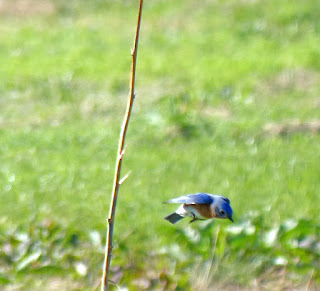 part of bluebird habitat that you can help provide for their success.
part of bluebird habitat that you can help provide for their success.Don't think caged bird perches or protected roosting tree perches in this case. Bluebirds are hunters. I have seen estimates that insects make up from 60-80% of a bluebird's diet. To catch insects, bluebirds like to scan the area around a perch and pounce on their prey on the ground or sometimes catch it midair. Because bluebirds hunt in open areas, their perches are often found on the edges of these areas, limiting their ability to hunt a large open area in its entirety. The chain link fence around my backyard is a favorite perch. I have also seen them on swing set beams, branches of shrubs
 and trees (especially before they leaf out so the birds have a good view of the area) and garden art that is somewhat tall and pole like.
and trees (especially before they leaf out so the birds have a good view of the area) and garden art that is somewhat tall and pole like.When I was mowing the back pasture this past winter there were a couple of tall, sturdy weeds whose main stalk remained after the first mowing pass. Since they were interior to the open area that bluebirds and a couple of other feathered friends like to hunt in from perches, I decided to leave a few of the sturdier stalks to expand the bird's hunting area. I was rewarded with bluebirds utilizing these perches and was lucky enough to get a few decent pictures of them in use. You can see a male bluebird scanning for prey and then swooping down to catch its prey in the pictures in this post.









